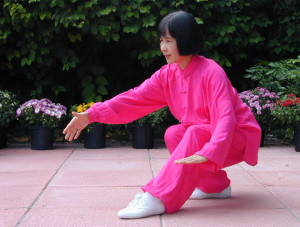Pre-Symposium Workshops A and B
With Master Han Hoong Wang
By PAT RICE, Director,
Program Department
A special part of the Symposium is the addition of two two-hour workshops scheduled Saturday, July 5. The Pre-Symposium workshops A and B are intended to provide those new to Tai Chi the foundation necessary for continued development and to deepen the understanding for experienced practitioners.
The Pre-Symposium workshops are scheduled to take place in the Spalding University Center gymnasium from 10:00 AM – 12:00 Noon and 2:00 – 4:00 PM Eastern Time on Saturday.
 Master Han Hoong Wang will present two 2-hour Pre-Symposium workshops. Both sessions have as their theme “Key Elements of Tai Chi Chuan” and both are designed to appeal to two audiences. The material introduces fundamental concepts and movements to beginner students who have little or no experience in the art, and identifies for experienced students at all levels the basic practices that are essential to making progress. Instructors also will find these workshops to be an excellent source of great teaching tips.
Master Han Hoong Wang will present two 2-hour Pre-Symposium workshops. Both sessions have as their theme “Key Elements of Tai Chi Chuan” and both are designed to appeal to two audiences. The material introduces fundamental concepts and movements to beginner students who have little or no experience in the art, and identifies for experienced students at all levels the basic practices that are essential to making progress. Instructors also will find these workshops to be an excellent source of great teaching tips.
Workshop A , on Saturday morning, “Key Elements of Tai Chi Chuan: Warm-ups and Single Tai Chi Chuan Movements” includes a number of warm-ups and stretches that can be used not only to accomplish the usual purpose of preparing the body for movement, but also to initiate awareness of the important connections between mind and body. It presents the purpose and method of the ubiquitous martial arts and qigong practice known as “standing meditation” or “post standing.” Prior to learning Tai Chi movements, one learns basics for stances and footwork and basics for hand shapes and patterns. After this, selected single movements are learned and provide a means of learning the process of how to move.
Workshop B, on Saturday afternoon, “Key Elements of Tai Chi Chuan: Techniques to Loosen the Mind and Body” has similar purposes but contains slightly different material. You’ll learn that all styles of Tai Chi Chuan are guided by classic principles, which are instructions about correct and efficient use of the body structure. Primarily, practice is done slowly, with deliberation and concentration, for specific purposes. Techniques may vary from one style to another or from one teacher to another, but there are training methods that are common to all of them.
